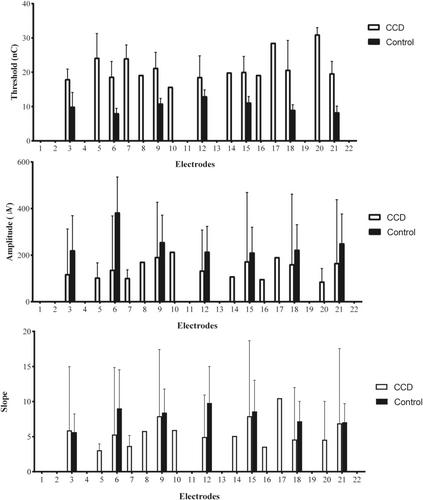Neural Responsiveness to Electrical Stimulation in Children With Common Cavity Deformity
Abstract
Objectives
To investigate neural responsiveness to electrical stimulation in children with common cavity deformity (CCD) after cochlear implantation (CI), compare these responses to those in children with normal cochlea, and analyze the influence of cavity volume and electrode position on these responses.
Methods
This is a case–control study. Participant included nine children with CCD and 11 children with normal cochlea. For each participant, electrically evoked compound action potentials (ECAPs) were measured, and input/output (I/O) functions were analyzed. The volume of the CCD, electrode to the fundus of the internal auditory canal (E-IAC) distance, and inner wall (E-IW) distance were measured on preoperative and postoperative imaging for children with CCD. Linear mixed-effects models (LMM) explored group differences and the influences of volume, E-IAC distance, and E-IW distance on ECAP responses for children with CCD.
Results
Children with CCD exhibited significantly higher ECAP thresholds and lower amplitudes than those with normal cochlea. The E-IAC distance has a significant influence on the ECAP threshold and maximum amplitude (ps < 0.05), but no significant effect on the I/O function slopes (p > 0.05). Neither cavity volume nor E-IW distance had a significant effect on ECAP responses (ps > 0.05). Most children in the CCD group achieved open-set speech perception, but their word and sentence recognition rates were significantly lower than those in the Control group (ps < 0.01).
Conclusion
Our findings demonstrated that there were a certain number of residual CNs in children with CCD; however, these nerves exhibited poorer responsiveness to electrical stimulation compared to children with a normal cochlea. Electrodes placed closer to the IAC fundus elicited stronger ECAP responses for children with CCD, which emphasized the importance of surgical strategies that minimize the distance between electrode contacts and residual cochlear nerve structures.
Level of Evidence: 3


 求助内容:
求助内容: 应助结果提醒方式:
应助结果提醒方式:


